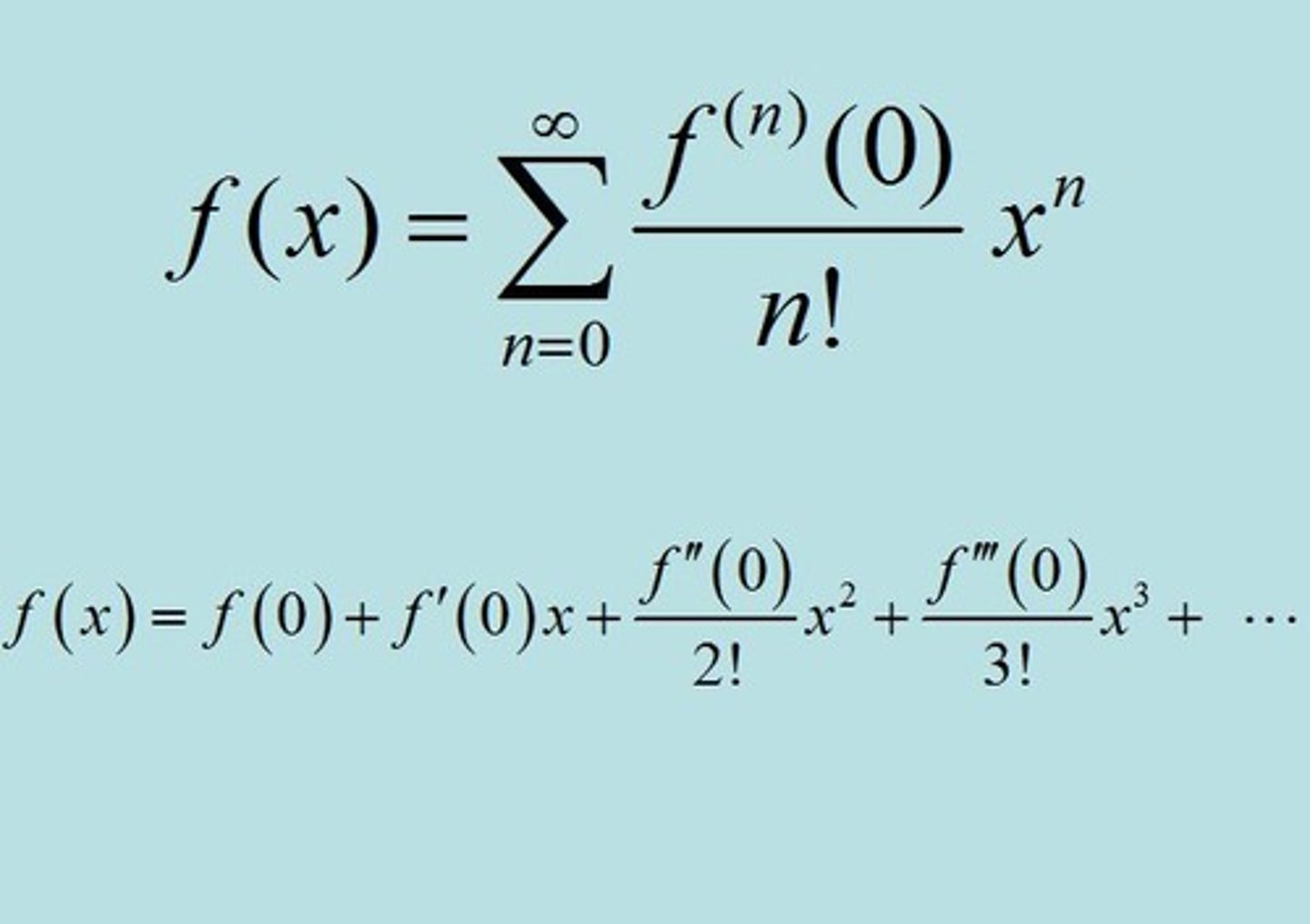Calculus 2
1/105
There's no tags or description
Looks like no tags are added yet.
Name | Mastery | Learn | Test | Matching | Spaced |
|---|
No study sessions yet.
106 Terms
d/dx cosx
-sinx
d/dx sinx
cosx
d/dx cotx
-csc^2(x)
d/dx tanx
sec^2(x)
d/dx secx
secxtanx
d/dx cscx
-cscxcotx
int cosx
sinx
int sinx
-cosx
int tanx
-ln|cosx| or ln|secx|
int secx
ln|secx+tanx|
int cscx
ln|cscx-cotx|
int sec^2(x)
tanx
int cscxcotx
-cscx
int secxtanx
secx
int csc^2(x)
-cotx
int cotx
ln|sinx|
Definition of e
lim k->infinity of
(1 + (1/k))^k
Which diverges by ration Test because e>1
(a^k)/(b^k)
(a/b)^k factoring out the power.
(k + 1)!
(k + 1)k!
2^(k + 1)
2 • 2^k
1 + cot^2(x)
csc^2(x)
tan^2(x) + 1
sec^2(x)
d/dx e^(u(x))
e^(u(x)) • u'(x)
d/dx e^x
e^x
int e^x dx
e^x + c
e
e^x will always be positive
d/dx ln(u)
1/u • du/dx
int (1/u) du
ln |u| + c
A of circle
pi • r^2
b^x
e^(x(lnb))
d/dx [arcsin(x)]
1/(sqrt: 1 - x^2)
d/dx [arctan(x)]
1/(x^2 + 1)
d/dx [arccos(x)]
-1/(sqrt: 1 - x^2)
d/dx [arccot(x)]
-1/(x^2 + 1)
d/dx [arcsec(x)]
1/ (|x|(sqrt: x^2 - 1))
d/dx [arccsc(x)]
-1/ (|x|(sqrt: x^2 - 1)
Integration by parts
uv - int: vdu
General Slicing Method
V= int: A(x)dx
Disk Method
V= int: pi[f(x)]^2 dx
Washer Method
V= int: piRouter^2 - piRinner^2 dx
Arc Length
L= int: sqrt ( (dy/dt)^2 + (dx/dt)^2) dy
tan^2(x)+1
sec^2(x)
Adjusting the starting index
from 1 to 0
Replace all the instances of n in the series with n+1
Geometric Series
S(n)=
Geometric Series
|r| < 1 converges
sum = a/(1-r)
Ratio Test
r<1 converges
r> diverges
r=1 inconclusive
Comparison Test
Find Bn>An if it converges then An converges.
Find Bn
P Test
P 1 series converges
Converges to 1/(p-1)
LCT
Take lim An/Bn. Choose Bn which you know if it converges/diverges.
Lim L, An and Bn converge or diverge together
Integral Test
Positive & decreasing. If integral converges --> series diverges; if ingtegral diverges --> series diverges
Series
Summation of sequence
Sequence
Set of numbers
LHopital
When lim fx and lim gx equals zero or pos/neg infinity. Lim of fx/gx equals lim f'x/g'x.
sin^2(x)
(1-cox2x)/2
Integral Remainder Theorem
int from n+1 to infinity of (f(x)dx <= R <= int fron n to infinity f(x)dx in
Alternating Series Test
if series is alternating
if Bn is positive
bn's are decreasing; Bn+1 <= Bn
limBn --> 0
series converges
Alternating Series Remainder theorem
|R| <= Bn+1 / R
Power series
Cn(x-a)^n
a = center
cn = coefficients
x = variable
Radius of Convergence
how far x can get from the center and the series can still converge; 1/2 of interval of convergence
Approximating Fn's w Power Series
put in form 1/1-(..)
Taylor Series
method for representing functions as a power series

Maclaurin Series

Taylor Series Remainder
Taylor's Inequality:
|Rn(x)| <= M/n+1! |x-a|^n+1
parametric to cartesian
solve for t and substitute
look for relationship between x and y and write it out
cartesian to parametric
copy cat --> set x = t or y = t and substitute
use a relationship to write it out
polar coordinates
(r, theta)
r = radius
theta = angles with positive x axis
polar coordinates x
x = rcostheta
polar coordinates y
y = rsintheta
polar coordinate r
r^2 = x^2 + y^2
polar coordinates tan
tan(theta) = y/x
Average Value of a Fn
int a to b ( f(x)dx) / b -a
on a continuous fn will always go through its average value
LIATE
log
inverse trig
Algebraic
Trig
Exponential
u is the first fn that comes up in the list
cos^2(x)
1/2 + 1/2cos2x
sin^2(x)
1/2 - 1/2cos2x
cos(2x)
cos^2(x) - sin^2(x)
Integrating Trig Powers
if sin is odd and cos even --> set aside a sin and u sub w cos
if sin is even and cos is odd --> set aside a cos and u sub w sin
if both odd --> choose either sin or cos to set aside and u sub w the other
if both even --> use different identities to reduce the exponents or number of sin and cos factors
work
force * distance
w varying force or distance
w = int a to b ( Force(x) dx )
Area between curves
int a to b ( large - small) or (top - bottom) or (right - left)
Trig Sub: sqrt(a^2 - x^2)
x = asin(x) and 1 - sin^2 = cos^2
Trig Sub: sqrt( a^2+x^2)
x = atan(x) and 1 + tan^2(x) = sec^2
Trig Sub: sqrt(x^2 - a^2)
x = asec(x) and sec^2 - 1 = tan^2
integrals of partial fractions will always work when
denominator factors into linear functions
and degree of numerator is lower than degree of denominator --> if not do long division and test the Remainder
series converges if
limit exists as a finite number
if lim of an doesn't go to zero
series cannot converge
if a sereis is bounded and monotonic
it will always converge
sin(2x)
2sin(x)cos(x)
int 1/(X^2 + a^2)
(1/a)arctan(x/a)
int lnx
xlnx - x
Ranking Growth Rate
ln^a(x) << x^a << a^x << x^x
inf + inf
determinate = inf
inf * inf
determinate
0/infinity
determinate = 0 * (1/inf) = 0
inf/0
determinate = inf * 1/0 = inf
inf / inf
indeterminate
0 / 0
indeterminate
inf * 0
indeterminate
inf - inf
indeterminate
0^0
Indeterminate
1^inf
Indeterminate